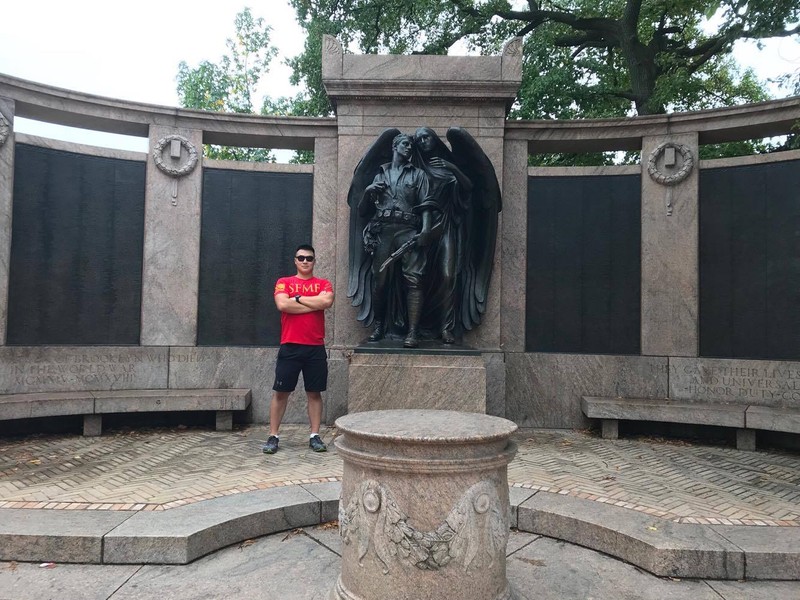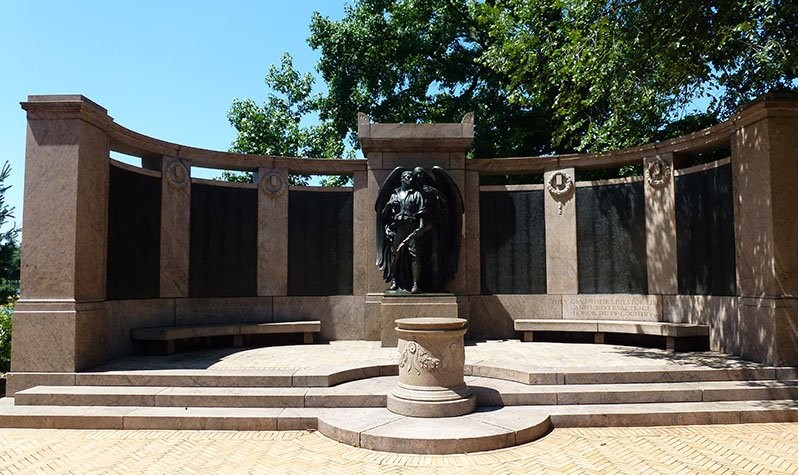Prospect Park War Memorial
Introduction
Text-to-speech Audio
Images
NYU student and the original author of this entry stands with the monument.

Prospect Park War Memorial honors the residents of Brooklyn who fought and died during the First World War.

Backstory and Context
Text-to-speech Audio
The Prospect Park War memorial is in the southeast corner of prospect park. It is a relatively small monument compared to its counterparts like the Grand Army Plaza dedicated to the defenders of the Union during the American Civil War. It is made of one statue and several plaques, the statue and plaques are made of bronze, and the benches, altar, and arced wall are made of granite. The statue shows the Angel of Death hovering over a soldier carrying a broken rifle. “Turning towards Death as if in a Trance” [3]. It shows the names of 2,800 Americans fallen in the name of protecting the Union, this time from a foreign enemy [1].
The monument was sculpted by the venerable Augustus Lukeman and designed by architect Arthur Pickering. August Lukeman has born January 1872 in Richmond Virginia and was a studio assistant of acclaimed Launt Thompson. He received formal training at the National academy for design and then studied at Columbia University. He then traveled to Paris to work under Jean-Alexandre-Joseph Falguiere. He then returned to America and became an assistant to Daniel C. French. His first work of art from his first studio was the Hebrew Psalmist, a façade also in Brooklyn New York. Lukeman was known for building many monuments throughout the city. But, in 1921, he finished the Prospect Park Memorial, which was the Monument dedicated to 2,800 Americans fallen in the First World War [2].
This monument was dedicated to men of the 14th Brooklyn, the famed “Red Legged Devils”, who fought under the 106th infantry regiment during the war; who in fact, held garrison in prospect park before being reassigned to its parent unit in order to help enlist new men [3]. The 106th infantry regiment fought in France under Colonel Franklin W. War and its sister regiment was the 105th. They moved into the line on 25 June, 1918, relieving the exhausted British 6th Division stationed there. It participated in the Ypres-Lys offensive and the Second Somme Offensive, which finally cracked the Hindenburg Line. The regiment suffered 1,955 casualties, with 1,496 wounded and 376 killed in action [4].
Sources
Works Cited:
1. “Prospect Park.” Prospect Park Monuments- Prospect Park War Memorial: NYC Parks. Accessed October 31, 2017. https://www.nycgovparks.org/parks/prospect-park/monuments/1229
2. Publishers, UpClosed. “Henry Augustus Lukeman Biography | Sculptor | United States of America.” UpClosed. Accessed October 31, 2017. https://upclosed.com/people/augustus-lukeman/
3. Gustafson, Andrew. “The Great War and NYC: Prospect Park.” Turnstile Tours. June 18, 2017. Accessed October 31, 2017. http://turnstiletours.com/the-great-war-and-nyc-prospect-park/
4. “106th Infantry Regiment World War One.” 106th NY Infantry Regiment during World War One – NY Military Museum and Veterans Research Center. October 25, 2017. Accessed October 31, 2017. https://dmna.ny.gov/historic/reghist/wwi/infantry/106thInf/106thInfMain.htm
Anonymous (October 31, 2017)
Avery Song (October 31, 2017)
